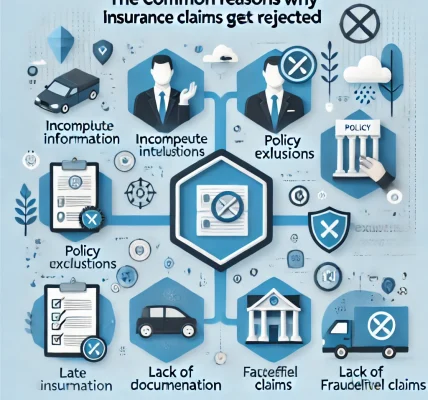When filing an insurance claim, policyholders often face a critical decision: should they submit their claim digitally or stick with the traditional paper method? While both have their advantages and drawbacks, choosing the right method can significantly impact the speed and efficiency of your claim processing.
In this guide, we’ll explore the differences between digital and paper claims, analyzing their efficiency, processing speed, security, and user experience to help you make an informed decision.
Understanding Digital and Paper Claims
What Are Digital Claims?
Digital insurance claims are submitted electronically through:
- Insurance company websites
- Mobile apps
- Email submissions
- Online claim portals
These claims leverage technology to automate and streamline the claims process, offering policyholders a faster and more user-friendly experience.
What Are Paper Claims?
Paper claims involve physically completing a claims form and mailing or faxing it to the insurance company. This method requires manual handling, which often leads to longer processing times.
While traditional, paper claims are still widely used by policyholders who are not comfortable with digital platforms or prefer physical documentation.
Digital vs. Paper Claims: Key Comparisons
1. Processing Speed
✅ Digital Claims:
- Faster submission – No postal delays; submitted instantly.
- Automated processing – Many insurers use AI-driven tools to quickly review and process claims.
- Real-time tracking – Many insurers provide updates on claim status via mobile apps or email.
❌ Paper Claims:
- Slower processing – Must be physically delivered and manually reviewed.
- Risk of postal delays – Mailed claims take days or weeks to arrive.
- No immediate status updates – Requires follow-up calls for claim status.
2. Convenience & Accessibility
✅ Digital Claims:
- Can be filed anytime, anywhere using a smartphone or computer.
- Reduces paperwork and eliminates the risk of lost documents.
- Uploading supporting documents (photos, receipts, etc.) is easy.
❌ Paper Claims:
- Require printing, filling, and mailing/faxing.
- Limited to business hours for submission.
- Higher chance of misplacement or document damage.
3. Accuracy & Error Reduction
✅ Digital Claims:
- Many digital systems use AI to detect missing information before submission.
- Automated systems reduce human errors in claim processing.
- Electronic forms have pre-filled fields to ensure data accuracy.
❌ Paper Claims:
- Handwritten forms can be misread or incomplete.
- Manual data entry by the insurer increases the risk of processing errors.
- Missing details often lead to delays or denials.
4. Security & Fraud Prevention
✅ Digital Claims:
- Uses encrypted communication to protect sensitive data.
- Can include biometric authentication (e.g., fingerprint/face ID).
- AI-powered fraud detection tools can flag suspicious claims.
❌ Paper Claims:
- Documents can be lost, stolen, or damaged in transit.
- Higher risk of identity theft if mailed documents fall into the wrong hands.
- Manual handling increases potential for document tampering.
5. Cost & Environmental Impact
✅ Digital Claims:
- Lower costs – No printing, postage, or storage costs.
- Eco-friendly – Reduces paper waste and carbon footprint.
- Saves insurers money, which can lead to lower premiums.
❌ Paper Claims:
- Higher costs – Requires paper, postage, and storage.
- Not environmentally friendly – Increases paper usage.
- Slower archiving – Physical records take up office space and are harder to retrieve.
Which One Is Better? Digital or Paper Claims?
Best Choice for Faster Processing: ✅ Digital Claims
If speed is a priority, digital claims are significantly faster. Insurers process online claims quicker due to automation and instant data verification.
Best Choice for User Convenience: ✅ Digital Claims
Filing a digital claim eliminates the hassle of paperwork, mailing, and follow-ups. It also allows users to track claim status in real-time.
Best Choice for Traditional Users: ✅ Paper Claims
For those uncomfortable with digital technology, paper claims provide a familiar process. However, be prepared for longer processing times.
Best Choice for Security: ✅ Digital Claims
With encrypted submissions and AI-driven fraud detection, digital claims offer more security than traditional paper-based methods.
Best Choice for Cost & Sustainability: ✅ Digital Claims
Paper claims are costly and contribute to environmental waste. Digital claims are more cost-effective and eco-friendly.
When Should You Use Paper Claims?
Despite the advantages of digital claims, paper claims may still be necessary in certain situations: ✔ If your insurer does not offer a digital claim option. ✔ If you prefer physical documentation for personal records. ✔ If you are not comfortable using technology. ✔ If a claim requires original physical documents (e.g., notarized statements).
Conclusion: The Future of Insurance Claims
While both digital and paper claims have their place, digital claims are undeniably the faster, more efficient, and more secure option. As insurance companies continue to embrace digital transformation, policyholders are encouraged to adopt electronic claim submissions for a smoother experience.
That said, paper claims remain a viable option for those who prefer traditional methods. However, be prepared for longer wait times and manual processes.




